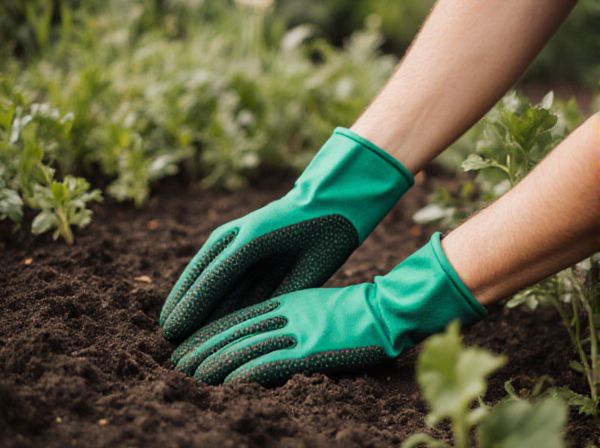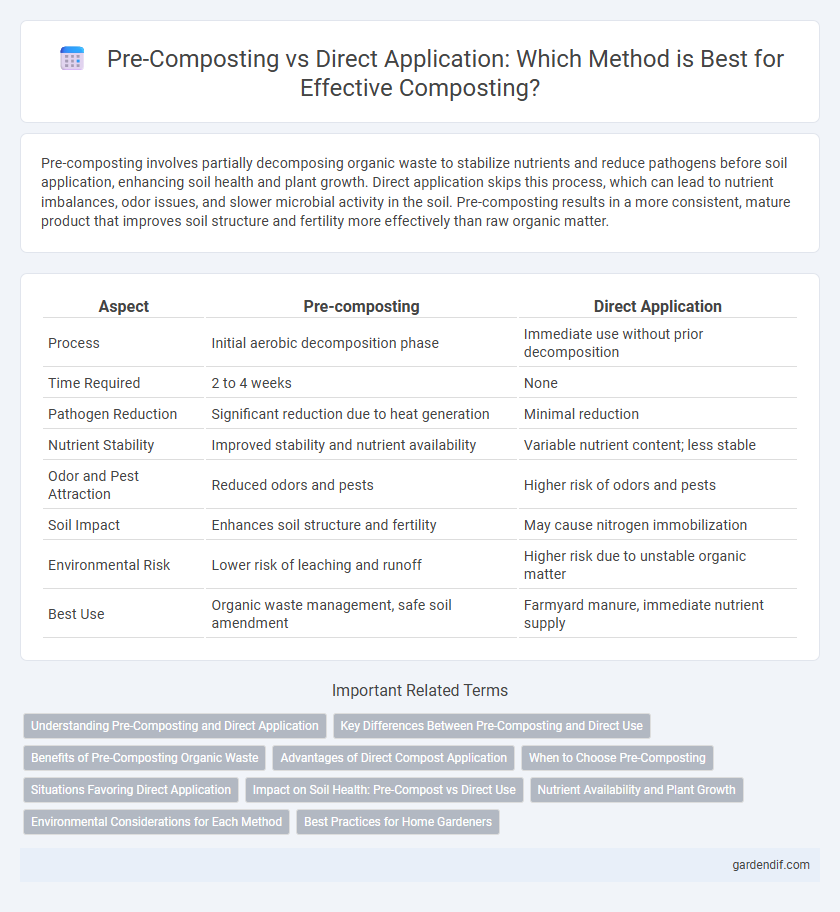
Pre-composting vs Direct Application Illustration
Pre-composting involves partially decomposing organic waste to stabilize nutrients and reduce pathogens before soil application, enhancing soil health and plant growth. Direct application skips this process, which can lead to nutrient imbalances, odor issues, and slower microbial activity in the soil. Pre-composting results in a more consistent, mature product that improves soil structure and fertility more effectively than raw organic matter.
Table of Comparison
| Aspect | Pre-composting | Direct Application |
|---|---|---|
| Process | Initial aerobic decomposition phase | Immediate use without prior decomposition |
| Time Required | 2 to 4 weeks | None |
| Pathogen Reduction | Significant reduction due to heat generation | Minimal reduction |
| Nutrient Stability | Improved stability and nutrient availability | Variable nutrient content; less stable |
| Odor and Pest Attraction | Reduced odors and pests | Higher risk of odors and pests |
| Soil Impact | Enhances soil structure and fertility | May cause nitrogen immobilization |
| Environmental Risk | Lower risk of leaching and runoff | Higher risk due to unstable organic matter |
| Best Use | Organic waste management, safe soil amendment | Farmyard manure, immediate nutrient supply |
Understanding Pre-Composting and Direct Application
Pre-composting involves partially decomposing organic waste under controlled conditions to stabilize materials and reduce pathogens before final composting or application. Direct application uses raw or minimally processed organic waste, which can provide immediate nutrient benefits but may carry risks of phytotoxicity and pathogen transmission. Understanding these methods helps optimize nutrient cycling and soil health while managing environmental and agronomic risks efficiently.
Key Differences Between Pre-Composting and Direct Use
Pre-composting stabilizes organic waste by partially decomposing it under controlled conditions, reducing pathogens and odors before soil application, whereas direct application involves spreading raw organic materials immediately on soil. Pre-composted material enhances nutrient availability and soil structure more consistently, while direct use may cause nitrogen immobilization and attract pests due to incomplete decomposition. Selection between these methods depends on waste type, desired nutrient release rate, and risk management related to pathogens and odors.
Benefits of Pre-Composting Organic Waste
Pre-composting organic waste stabilizes materials by partially decomposing them, reducing pathogens and phytotoxins, which enhances the safety and quality of the final compost. This process improves nutrient availability and minimizes nitrogen loss, leading to more efficient nutrient recycling and higher soil fertility. Pre-composted waste also reduces odors and pests compared to direct application, promoting better environmental and operational conditions for agricultural or horticultural use.
Advantages of Direct Compost Application
Direct compost application enhances soil nutrient availability immediately, promoting faster plant growth and improved crop yields. It reduces handling time and labor costs by eliminating the pre-composting phase, making it more efficient for large-scale agricultural operations. Moreover, direct application supports soil moisture retention and microbial activity, fostering healthier soil ecosystems.
When to Choose Pre-Composting
Pre-composting is essential when dealing with high-moisture or high-nitrogen waste to stabilize organic materials and reduce phytotoxic compounds. It is optimal for materials containing pathogens, weed seeds, or contaminants that require decomposition before safe soil application. Choosing pre-composting enhances nutrient availability, minimizes odor problems, and improves overall soil health compared to direct application of raw organic waste.
Situations Favoring Direct Application
Direct application of organic waste is favored in situations with limited time or resources for composting, such as small-scale gardening or urgent soil amendment needs. It benefits soils deficient in organic matter where immediate nutrient input is critical, especially in areas with active microbial communities that rapidly break down fresh material. This approach suits warm, moist climates that promote quick decomposition, minimizing the risk of phytotoxicity commonly associated with raw waste.
Impact on Soil Health: Pre-Compost vs Direct Use
Pre-composting stabilizes organic matter, reducing phytotoxic compounds and pathogens, which enhances soil microbial activity and nutrient availability more effectively than direct application. Direct use of raw organic waste can lead to nitrogen immobilization and phytotoxicity, negatively impacting seed germination and soil health. Pre-composted material improves soil structure, water retention, and promotes sustainable nutrient cycling, making it superior for long-term soil fertility.
Nutrient Availability and Plant Growth
Pre-composting stabilizes organic matter and enhances nutrient availability by converting complex compounds into simpler forms, leading to improved plant nutrient uptake and growth. Direct application of raw organic waste can cause nitrogen immobilization, resulting in nutrient lock-up and potential phytotoxicity that inhibits seedling development. Therefore, pre-composting optimizes nutrient profiles and promotes healthier, more vigorous plant growth compared to direct application.
Environmental Considerations for Each Method
Pre-composting stabilizes organic waste by reducing pathogens and greenhouse gas emissions before soil application, minimizing environmental risks such as nutrient leaching and odor generation. Direct application of raw organic materials can lead to higher nitrogen volatilization and methane production, increasing air pollution and groundwater contamination risks. Choosing pre-composting supports sustainable waste management by enhancing nutrient retention and reducing carbon footprint compared to direct application.
Best Practices for Home Gardeners
Pre-composting garden waste before application enhances nutrient availability and reduces the risk of plant disease by allowing organic matter to partially decompose, stabilizing nutrients for gradual release. Direct application of raw materials can lead to nitrogen immobilization and may introduce pathogens or weed seeds into the soil, potentially harming sensitive plants. Home gardeners achieve optimal soil health and plant growth by using pre-composted materials, ensuring thorough decomposition and proper moisture levels during composting.
Pre-composting vs Direct Application Infographic

 gardendif.com
gardendif.com